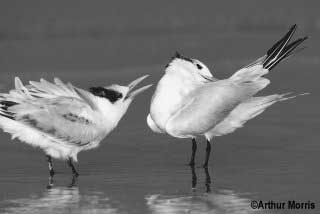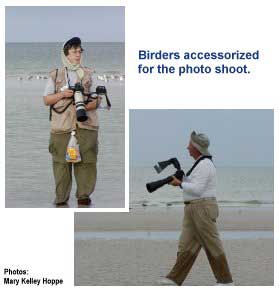|
Beachwalking with Art Morris
by Mary Kelley Hoppe
 We arrive at Ft. DeSoto before dawn, a dozen or so camera-lugging shutterbugs in hot pursuit of shorebirds. But first we huddle in the parking lot with acclaimed bird photographer Art Morris, who instructs us on the basics: We arrive at Ft. DeSoto before dawn, a dozen or so camera-lugging shutterbugs in hot pursuit of shorebirds. But first we huddle in the parking lot with acclaimed bird photographer Art Morris, who instructs us on the basics:
Lesson one: Don't drop your lens - especially if your optics came with price tags ending in three or more zeros. Lens-crashing disasters, says Morris, are often the result of sloppy tripod setup or leaving a camera-heavy tripod unmanned, even for an instant - enough time for an errant foot or hefty breeze to splay your equipment on the ground.
Lesson two: Woolen caps are a photographer's best friend - even in Florida. Morris uses them to cushion expensive lenses, and keep batteries from knocking around. They are the basis of his system.
Lesson three: Never go out in the field carting a bag of stuff. Morris worships at the altar of self-containment. Donning a photo vest chock full of essentials - water, sunblock, plastic bags, teleconverters, lens cleaners, a small tool kit and a crushed loaf of Wonder Bread dangling from a belt hoop - he practices what he preaches. "One thing I'm not is anal-retentive," he says. "I put this thing on and go."
Lesson four: Idiot-proof your equipment. Morris stresses the importance of double-checking equipment before heading out, to avoid the heartbreak of shooting the picture of a lifetime sans film or running out of digital memory just as a mangrove cuckoo flies into the frame. And proof that even the masters have their mortal moments: Morris turns on his camera only to find its digital memory card is missing, then inserts a memory card that's already full.
After parking lot lessons, we move out, silent soldiers on the great avian trail. Ft. DeSoto's north beach not only ranks as one of the most beautiful beaches in America, it's also a birder's paradise, attracting extraordinary numbers of shorebirds from the elegant tern to the diminutive piping plover, which arrives in late summer from Canada and the Great Lakes. Morris also likes the East Beach at high tide. "It's phenomenal in the afternoon for photographing from your car."
His stunning images have been featured in galleries and magazines worldwide including National Geographic. His instructional photo tours to North America's top birding spots draw budding and serious photo-enthusiasts eager to hone their skills.
On this October morning the beach is alive with pelicans, terns, gulls, willets and a smattering of great blue herons, all engaged in boisterous conversation. A sweet breeze amplifies the clatter of squawks, chirps, clicks and staccato whistles. An adult royal tern sails overhead dangling a tiny fish as our ground patrol edges closer to the action.

Royal terns in winter plumage.
We come in peace
 Picture 18 people, saddled with enough equipment to stock a small convenience store, trying to sneak up on a flock of birds. Morris advises us to stay tight. When we are about a hundred feet away, he cues us to take down the tripods slung over our shoulders like alien antennae and carry them in front of us to avoid startling the birds. Less important than noise, Morris says, is sudden movement. We continue advancing slowly, avoiding eye contact with our feathered friends. Picture 18 people, saddled with enough equipment to stock a small convenience store, trying to sneak up on a flock of birds. Morris advises us to stay tight. When we are about a hundred feet away, he cues us to take down the tripods slung over our shoulders like alien antennae and carry them in front of us to avoid startling the birds. Less important than noise, Morris says, is sudden movement. We continue advancing slowly, avoiding eye contact with our feathered friends.
The group is a study in feigned nonchalance - but the birds, good sports all, humor us and let us closer.
My digital point-and-shoot camera, sufficient for most of my photography needs, simply doesn't stack up in this clique of thousand-dollar-plus lenses capable of zooming in from great distances on the most intricate details. So I set my sights and lens on a subject closer at hand and far more interesting - the birders themselves.
This particular flock runs the gamut from little old ladies and lawyers to computer professionals and serious photographers new to the birding scene.
A half-hour later, my inner beach bum calls. I stash my camera and join local resident Pam Bourke on the sand for some seaside reflection while the more serious enthusiasts - including Pam's husband, Al - continue clicking away. A long-time resident of Seminole, Bourke relishes the coastal life. "Other than having to work, it's just like being on vacation."
Soon after, we huddle up for the trek back to the parking lot. En route, we encounter a single juvenile yellow-crowned night heron so unmoved by our presence that he lets us with a few feet before deigning to awake from his nap and open his eyes. It's my first and only decent bird shot of the day, a good finish to a satisfying morning.
Once again, Ft. DeSoto has cast its spell on another visitor, and a lucky band of photographers heads home savoring the day's images.
|
Tips for Nature Photographers
Two photographers share their tips for taking great photographs.
|
|
One of North America's premier bird photographers, Arthur Morris (Birds As Art) is a frequent and popular headliner at the Florida Birding Festival in St. Petersburg.
Tampa photographer Donna Bollenbach (Flora & Fauna Fotography) shared her secrets for nature photography with students at "Estuary Academy," created by the Tampa Bay Estuary Program as part of last year's Bay Area Scientific Information Symposium 4.
Art Morris: The most common mistake beginners make, says Morris, is handholding their camera instead of using a tripod.
For best results:
- To get close, stay low and move slowly.
- Point your shadow at the bird.
- Buy a longer slower lens rather than a faster shorter lens for photographing birds. For those using digital cameras with multiplier effects in the 1.3 to 1.6 range, a 300 or 400 mm lens can get you into the ballpark, but a 500 or 600 mm lens with a 1.4 and 2X teleconverter is ideal.
- When shooting in a horizontal format, try to keep the bird out of the center of the frame.
- Try to find spots where birds are acclimated to people. Gulls make great practice subjects. They're typically pretty tame and often do interesting things the moment you point the lens at them.

A sandwich tern sails overhead carting a morning snack.
Photo: ©Arthur Morris
|
Donna Bollenbach: Good photography is like writing haiku, says Bollenbach. "You use the fewest possible elements to make a powerful statement."
Unlike painting where you add media to a canvas, Bollenbach says the best photography is achieved by subtracting or eliminating distracting elements from the frame.
- Buy a sturdy tripod and use it.
- Keep compositions simple and reduce clutter by recomposing your shot - panning left or right - as necessary.
- Get down (or up) to eye level for the best shots, especially with small animals. Bollenbach literally lays on the ground for many of her shots.
- Experiment with your lenses. While some people assume wide angle lenses are just for landscapes, because you can focus very close with a wide angle lens they add great perspective when shooting frame-filling wildflowers or foliage.
- And while you're experimenting, don't be afraid to shoot the same scene from different perspectives. Although vertical subjects are typically photographed vertically, and horizontal objects horizontally, you may be delightfully surprised by what you get when you try both perspectives.
- Enjoy! Don't get so hung up looking for a picture that you forget to enjoy and appreciate what you came to photograph in the first place.

A young alligator basks in the sun.
Photo: ©Donna Bollenbach
|
| |